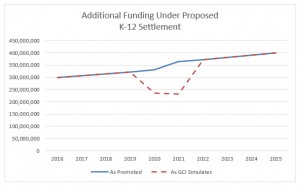 Press Release
Press Release
Report: Prop. 123 Essential but Only First Step in Addressing More than $2 Billion Shortfall in K-12 Spending, Arguably Worst in the Nation
January 7, 2016Press Release
CONTACT: Dave Wells, Ph.D.
Research Director, Grand Canyon Institute
(602) 595-1025 ext 3
Full Report on line: https://grandcanyoninstitute.org/wp-content/uploads/2016/01/GCI_Policy_Paper_Prop123andK12Underinvestment_Jan-7_2016.pdf
Report: Prop. 123 Essential but Only First Step in Addressing More than $2 Billion Shortfall in K-12 Spending, Arguably Worst in the Nation
PHOENIX —The Grand Canyon Institute released on Thursday a report endorsing Prop. 123 as a solution to settling the Cave Creek v. Arizona lawsuit over the state’s failure to meet minimum legal levels for base level student funding.
However, the report cautions that Prop. 123, while an essential first step, is insufficient to meet the broader challenge of funding K-12 education, arguing that Arizona’s state-sourced funding of K-12 education is the lowest in the country and has declined on an inflation-adjusted basis over the last two decades. Wells, research director of the Institute and author of the study said, “excessive tax cuts since 1993 now take $4 billion from the General Fund, leaving insufficient resources to meet the need of properly funding education.”
Wells, research director of the Institute and author of the study said, “excessive tax cuts since 1993 now take $4 billion from the General Fund, leaving insufficient resources to meet the need of properly funding education.”
Even if Prop. 123 is passed, the K-12 funding gap which is already $1 billion relative to spending levels in 2007 will increase by 2026 to more than $2 billion, mostly from the expiration of the state 0.6 percent sales tax after 2021.
Most alarming according to Wells, “while the state’s pupil-teacher ratio is now the third highest in the country, state-sourced K-12 spending per teacher has dropped to 40 percent of the national average, easily the lowest the country.”
The report argues that Prop. 123 provides a good balance by providing greater flexibility for legislators to avoid automatic inflation adjustments during tight fiscal times, while requiring those monies later be added when fiscal times improve.
However, inflation-only adjustments are not the same as adequately funding K-12 education, as it isn’t an increase in funding, but merely adjusting current levels for changes in price levels. Meanwhile, as the Arizona Department of Education’s retention report from last January noted, turnover in the teaching profession is alarmingly high as teachers leave the profession for better paying jobs either outside teaching or in other states with lower pupil-teacher ratios.
The report forecasts one recession in the 2016-2025 time period leading to a couple years where no inflation or a partial inflation adjustment will be applied, leading to a slight decrease to $3.3 billion in funds going to schools under Prop. 123 instead of the $3.5 billion that has been touted by the Governor.
The report finds the increase to a 6.9 percent distribution from 2.5 percent from the Common School Trust Fund to be workable for ten years because returns from the trust fund after controlling for inflation are normally about 4 percent. Since the current 2.5 percent will return after 2025, the state can afford a few years where more than 4 percent is taken from the trust fund.
The Grand Canyon Institute was founded in 2011 to provide a centrist, economic analysis to state fiscal policy by a bipartisan group of leaders including former elected officials.
Two Figures from the report:

